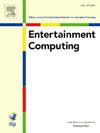游戏化数字治疗减少儿童围手术期焦虑:探索多感官互动体验
IF 2.4
3区 计算机科学
Q2 COMPUTER SCIENCE, CYBERNETICS
引用次数: 0
摘要
围手术期患儿常出现高度焦虑,影响治疗效果。游戏化的数字治疗一直被视为一种很有前途的方法,然而,许多流行的工具并没有被设计成准确地满足儿童的需求。本研究采用定性与定量相结合的用户研究方法,明确儿童需求与多感官设计元素(视觉、听觉、触觉)、干预措施之间的关系,并提出游戏的干预机制。在此基础上,我们提出了一个基于多感官互动体验的儿童游戏化干预系统。最后,通过原型实现和随机对照实验对系统的可用性和有效性进行了评估。结果显示,30名计划接受治疗的儿童被随机分为对照组和游戏化组。根据脑电图结果(0.67 vs. 0.70;0.69 vs. 0.42;0.67对0.38),与接受常规医疗(没有游戏化干预)的儿童相比,使用该系统的儿童的焦虑水平明显降低了42%。同时,家长满意度(M = 4.27);游戏化组m-YPAS焦虑量表(Cohen’s = 2.809)。我们证实该系统可以被认为是减少围手术期儿童焦虑的一种新的有效工具。本文章由计算机程序翻译,如有差异,请以英文原文为准。
Gamified digital therapy for reducing perioperative anxiety in children: Exploring multi-sensory interactive experience
Children often experience high levels of anxiety during the perioperative period, resulting in affecting the treatment outcome. Gamified digital therapy has been as a promising approach, however, many popular tools have not been designed for accurately meet the needs of children. This study uses a combination of qualitative and quantitative user research to clarify the relationship between children’s requirements, multisensory design elements (visual, audio, tactile), and intervention measure, and proposes the game’s intervention mechanics. Based on it, we propose a gamified interventions system based on multisensory interactive experiences intervenes for children. Lastly, prototype implementation and randomized controlled experiments were assessed the usability and validity of proposed system. The result showed that 30 children scheduled for treatment a were randomly divided into either the control or gamification group. According to EEG results (0.67 vs. 0.70; 0.69 vs. 0.42; 0.67 vs. 0.38), children using the system showed significantly lower about reducing 42 % levels of anxiety, compared to children who received regular medical treatment (without gamified intervention). Meanwhile, parent satisfaction (M = 4.27); m-YPAS anxiety scale in gamification group (Cohen’s = 2.809). We confirmed that the system can be considered a new and effective tool for reducing children’s anxiety in perioperative period.
求助全文
通过发布文献求助,成功后即可免费获取论文全文。
去求助
来源期刊

Entertainment Computing
Computer Science-Human-Computer Interaction
CiteScore
5.90
自引率
7.10%
发文量
66
期刊介绍:
Entertainment Computing publishes original, peer-reviewed research articles and serves as a forum for stimulating and disseminating innovative research ideas, emerging technologies, empirical investigations, state-of-the-art methods and tools in all aspects of digital entertainment, new media, entertainment computing, gaming, robotics, toys and applications among researchers, engineers, social scientists, artists and practitioners. Theoretical, technical, empirical, survey articles and case studies are all appropriate to the journal.
 求助内容:
求助内容: 应助结果提醒方式:
应助结果提醒方式:


